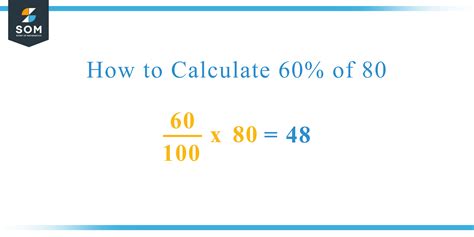60 Is What Percentage Of 80
Kalali
Mar 31, 2025 · 4 min read

Table of Contents
60 is What Percentage of 80? A Comprehensive Guide to Percentage Calculations
Understanding percentages is a fundamental skill applicable across numerous fields, from everyday finances to complex scientific calculations. This article delves deep into the question, "60 is what percentage of 80?", providing not only the answer but also a comprehensive explanation of the underlying principles and various methods for solving similar percentage problems. We'll explore different approaches, offering clarity and building a strong foundation for tackling percentage calculations with confidence.
Understanding Percentages: The Basics
Before we dive into the specific problem, let's establish a solid understanding of what percentages represent. A percentage is simply a fraction expressed as a part of 100. The symbol "%" signifies "per cent," or "out of 100." Therefore, 50% means 50 out of 100, which is equivalent to the fraction 50/100 or the decimal 0.5.
Method 1: Using the Formula
The most straightforward method to determine what percentage 60 is of 80 involves a simple formula:
(Part / Whole) * 100% = Percentage
In our case:
- Part: 60 (the number we want to express as a percentage)
- Whole: 80 (the total amount)
Substituting these values into the formula, we get:
(60 / 80) * 100% = 75%
Therefore, 60 is 75% of 80.
Method 2: Simplifying the Fraction
Alternatively, we can simplify the fraction before multiplying by 100%. This method offers a cleaner approach, especially with larger numbers:
- Form the fraction: 60/80
- Simplify the fraction: Both 60 and 80 are divisible by 20. Simplifying gives us 3/4.
- Convert to percentage: To express 3/4 as a percentage, multiply the fraction by 100%: (3/4) * 100% = 75%
Again, we arrive at the answer: 60 is 75% of 80.
Method 3: Using Decimal Equivalents
This method involves converting the fraction to a decimal and then multiplying by 100%.
- Form the fraction: 60/80
- Convert to decimal: Divide 60 by 80: 60 ÷ 80 = 0.75
- Convert to percentage: Multiply the decimal by 100%: 0.75 * 100% = 75%
This method confirms our previous results: 60 is 75% of 80.
Expanding the Understanding: Variations and Applications
Now that we've definitively answered the core question, let's explore how this knowledge applies to various scenarios and related percentage problems.
Finding the Whole when Given the Percentage and Part
Let's say we know that 75% of a number is 60. How do we find the whole number? We can adapt the formula:
(Part / Percentage) * 100 = Whole
(60 / 75) * 100 = 80
This confirms our original calculation. This reversed calculation is crucial for various applications, including calculating the original price before a discount or determining the total population based on a sample percentage.
Finding the Part when Given the Percentage and Whole
Suppose we want to find 25% of 80. We use the original formula:
(Percentage/100) * Whole = Part
(25/100) * 80 = 20
Therefore, 25% of 80 is 20. This is frequently used in calculating discounts, taxes, or calculating portions of a whole.
Percentage Increase and Decrease
Understanding percentages also allows us to calculate percentage increases and decreases. For example, if a value increases from 80 to 100, the percentage increase is calculated as follows:
- Find the difference: 100 - 80 = 20
- Divide the difference by the original value: 20 / 80 = 0.25
- Multiply by 100%: 0.25 * 100% = 25%
Therefore, the value increased by 25%. Similarly, we can calculate percentage decreases.
Real-World Applications of Percentage Calculations
The ability to calculate percentages is essential in many real-life situations:
- Finance: Calculating interest rates, discounts, taxes, profit margins, and investment returns.
- Retail: Determining sale prices, markups, and discounts.
- Science: Expressing experimental results, calculating concentrations, and analyzing data.
- Statistics: Representing data using percentages, creating charts and graphs.
- Everyday Life: Tipping in restaurants, calculating sale prices, understanding nutritional information.
Mastering percentage calculations enhances your ability to make informed decisions and understand numerical information presented in various contexts.
Tips and Tricks for Mastering Percentage Calculations
- Practice regularly: The more you practice, the more comfortable you'll become with the formulas and methods.
- Use different methods: Experiment with various approaches to find the method that best suits your understanding and the specific problem.
- Check your work: Always double-check your calculations to avoid errors.
- Use a calculator: For more complex calculations, a calculator can help ensure accuracy.
- Understand the concepts: Don't just memorize formulas; understand the underlying principles of percentages and fractions.
Conclusion
This comprehensive guide has provided a detailed explanation of how to calculate what percentage 60 represents of 80, demonstrating multiple methods and exploring various applications of percentage calculations. By understanding the fundamental principles and practicing regularly, you can confidently tackle percentage problems in any context, improving your numerical literacy and decision-making skills across a wide range of situations. Remember, the key is to understand the core concepts and practice consistently. With sufficient practice, calculating percentages will become second nature, empowering you to analyze data and make informed decisions with ease.
Latest Posts
Latest Posts
-
Como Calcular El Area De Un Triangulo Con 2 Puntos
Apr 02, 2025
-
What Is 19 20 As A Percent
Apr 02, 2025
-
2 Is What Percent Of 9
Apr 02, 2025
-
A Limit Involving The Cosine Function
Apr 02, 2025
-
How Much Is 36 Inches In Feet
Apr 02, 2025
Related Post
Thank you for visiting our website which covers about 60 Is What Percentage Of 80 . We hope the information provided has been useful to you. Feel free to contact us if you have any questions or need further assistance. See you next time and don't miss to bookmark.
